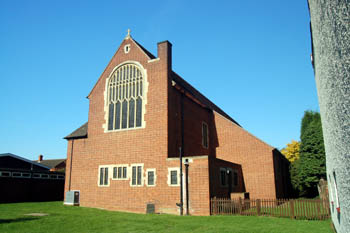The Creation of The Church of The Transfiguration Kempston

The Church of The Transfiguration from the north-east September 2007
Until the middle of the 19th century the growing urban population of Kempston has to walk to All Saints' Church at Church End, in what is now Kempston Rural, to attend divine service, or walk to Saint Leonard's church just over the parish boundary in Bedford. The Church of England set about rectifying this situation in 1855 when the National School at Up End was adapted to serve as a chapel of ease.
In 1867 Saint John's chapel of ease was built in Up End, followed by Saint Stephen's in Spring Road in 1887. By the 1920s, however, it was decided to replace both these structures with a single, better, building. In 1927 Anne Charles-Williamson died and left £8,000 to build a church in New Town. Plans were drawn up by architect Ivan Daughtry in 1931 but these came to nothing and six years later a new design was prepared by J. Harold Gibbons. This used brick and a revised Gothic style influenced by the late Victorian Arts and Crafts Movement. The foundation stone was laid on 31st July 1938 and the church consecrated two years later on 14th July 1940.
The church was built by Kempston firm Samuel Foster Limited and includes a regimental chapel in the north aisle. A separate baptistery includes a carved stone font of 1868 which used to stand in Saint John's church. The church was originally a chapel of ease to All Saints but became a conventional district in 1967 and finally became a separate parish in 1976, the former priest in charge becoming the vicar.
Most of the notes on the structural history of the church can be found in greater detail in Bedfordshire Historical Record Society Volume number 80 of 2001 Bedfordshire Churches in the Nineteenth Century: Part IV: Appendices and Index, put together by former County Archivist Chris Pickford from numerous sources some held by Bedfordshire & Luton Archives & Records Service and some held elsewhere or published.